Publication Information
ISSN: 2641-6859
Frequency: Continuous
Format: PDF and HTML
Versions: Online (Open Access)
Year first Published: 2018
Language: English
| Journal Menu |
| Editorial Board |
| Reviewer Board |
| Articles |
| Open Access |
| Special Issue Proposals |
| Guidelines for Authors |
| Guidelines for Editors |
| Guidelines for Reviewers |
| Membership |
| Fee and Guidelines |
 |
Volatility of Public Interest in Orthopaedics during the COVID-19 Pandemic
Maxwell Davison-Kerwood2 BA, Elana Gordy1* BS, Julio Castillo Tafur2 BA BS, Ye Lin2 MD, Nicholas Boroda2 MD, Mark H Gonzalez2 MD PhD
1University of Illinois College of Medicine, Chicago, IL
2University of Illinois Department of Orthopedic Surgery, Chicago, IL
Received Date: July 30, 2022; Accepted Date: August 12, 2022; Published Date: August 18, 2022;
*Corresponding author: Elana Gordy. University of Illinois College of Medicine, Chicago, IL. Email: egordy2@uic.edu
Citation: Davison-Kerwood M, Gordy E, Castillo Tafur JC, Lin Y, Boroda N, et al. (2022) Volatility of Public Interest in Orthopaedics During the COVID-19 Pandemic. Adv Ortho and Sprts Med: AOASM-167.
DOI: 10.37722/AOASM.2022401
Abstract
Background
Several studies have demonstrated the decrease of public interest in elective orthopaedic surgeries throughout the beginning and middle of the COVID-19 pandemic, but none have assessed the return, if any, of public interest as the pandemic has progressed.
Questions/Purpose
Apply a user-friendly tool and replicable methodology to (1) determine differential impacts of COVID-19 on search frequencies for exploratory and interventional search terms; (2) evaluate if public interest towards some common orthopaedic symptoms and their respective elective procedures have returned to pre-pandemic baseline.
Method
Google search frequencies for common orthopaedic procedures and symptoms were extracted from Google Extended Trends for Health (GETH) between January 7th, 2018, and January 15th, 2022, using the Google Trends Information Extraction Tool. Queried terms were split into two categories: exploratory and interventional. Control limit analysis was performed for each search term to determine special cause variations and assess any recovery.
Results
All search terms saw significant decreases the week of March 15th, 2020, and five of the six saw at least one more drop during the 2020 holiday season. Search volumes for exploratory terms initially fell less and recovered nearly four times faster compared to search volumes for interventional terms, but volatility of public interest was seen until the end of the study window.
Conclusions
Public interest in elective orthopaedic procedures continues to be chaotic during this pandemic. This study is the first to assess the initial recovery of public interest in elective orthopaedic procedures in the COVID-19 era using a novel application of the Google Trends Information Extraction Tool and provides a timely update on changes in public perception as the pandemic has progressed. These results can be used to better understand, quantify, and potentially anticipate the interests of the national patient population and tailor care, public outreach programs, or policy based on real-time search trends.
Level of Evidence: V
Introduction
An estimated 41% of U.S. adults have delayed accessing healthcare during the COVID-19 pandemic [10]. Early in the pandemic, orthopaedics was predicted to have a total surgical backlog of greater than one million cases two years after elective surgeries had been hypothesized to have resumed [13]. This prediction is likely dramatically underestimating the effects of the pandemic as elective surgeries in many regions have continued to be put on hold secondary to staffing shortages from COVID-19 outbreaks of new variants in January 2022.
Given this backlog, orthopaedic surgeons, hospital systems, and policymakers would benefit from gaining an accurate understanding of the public interest towards orthopaedics to better prepare for their forthcoming needs. One patient survey of 360 total joint arthroplasties canceled due to COVID-19 showed that 90% of patients desired surgery as soon as possible, although they did express significant anxiety regarding COVID-19 transmission when seeking care [7]. Waiting for a surgical procedure is associated with decreased quality of life, with 12% of patients waiting for a knee replacement and 19% of patients waiting for a hip replacement describing themselves in a state “worse than death” [23]. While these studies demonstrate that there is a significant proportion of patients who would benefit from orthopaedic intervention as soon as possible, they fail to assess timely and regional changes in public interest towards orthopaedics, a gap for which the application of Google search volumes has become highly efficacious.
Google search volumes allow researchers to gauge public interest in almost any subject across the United States. These search volumes can be accessed via the open access platform Google Trends or via the platform designed specifically for healthcare researchers, Google Extended Trends API for Health (GETH), which gives increased data granularity and accuracy. These platforms allow users to query Google search data within a window of time and specific region, and their use in research has increased 20-fold from 2009 to 2018 [2]. Besides being used to track elective procedures across various specialties, Google search volumes has also been used to track public interest in cancer, suicide, vaccinations, and more [2, 5, 24, 27]. Considering this increasing momentum, using Google data to support major decision making and research may be commonplace in the near future, especially when paired with machine learning algorithms. For example, Poirier et al. were able to detect influenza outbreaks faster than the Center for Disease Control (CDC) [20]. Prior to the release of the Google Trends Extraction Tool in December 2020, data from GETH was only able to be extracted using coding languages such as Python, and the data and extraction methodology have been critiqued on their accuracy and reproducibility [18, 21]. Google Trends studies in orthopaedics after the COVID-19 pandemic have neither used the Google Trends Extraction tool nor assessed the recovery, if any, of public interest in elective orthopaedic procedures [14, 15, 24, 26]. However, increased public interest in orthopaedic symptomatology and procedures, measured via Google Trends, has been positively correlated to claims data and surgical procedures performed, making this work highly relevant to orthopaedic stakeholders [3, 9, 22, 27].
This study aims to utilize this user-friendly Google Trends Extraction tool and demonstrate a replicable methodology to (1) determine differential impacts of COVID-19 on search rates of exploratory and interventional terms; (2) evaluate if public interest towards some common orthopaedic symptoms and their respective elective procedures have returned to baseline. Given the proven relationship between public interest and surgical procedures, the results of this investigation will allow orthopaedic surgeons, hospital systems, and policymakers to better understand the effect that COVID-19 had on their patients and better anticipate the resurgent caseload.
Methods
Institutional Board Review approval was not required for this study. An API key was applied for and received from Google. Popular elective rather than urgent or emergent orthopaedic procedures was the focus of this study. Knee, hip, and shoulder symptoms and interventions were the focus of this study given the high frequency of these orthopaedic complaints and procedures. Google search frequency for orthopaedic symptoms and their respective elective procedures was extracted from GETH between January 7th, 2018, and January 15th, 2022, using the Google Trends Extraction Tool [21]. Data was collected from only within the United States using 200 samples. Sampling frequency was selected to increase data accuracy as noted by Raubenheimer et al. and in the Google Trends Extraction Tool help file [21].
Paired query terms were split into two categories: exploratory and interventional. The exact terms were selected by using the “Top Topics” and “Top Queries” features of the Google Trends Extraction Tool. This feature returns the search terms of the highest frequency or on relevant topics to the original search term, allowing users to fine-tune the search criteria for more accurate data collection. “Pain” was the most common exploratory term, and it was paired to anatomical regions (i.e., “hip pain”) to specify searches for hip-related issues from more general searches relating to pain. This resulted in an exploratory category including “hip pain”, “knee pain”, and “shoulder pain”. The interventional category included “hip surgery + hip replacement + total hip arthroplasty + arthroscopic hip surgery + hip labrum surgery”, “knee surgery + knee replacement + meniscus surgery + acl surgery + arthroscopic knee surgery + total knee arthroplasty”, “shoulder surgery + shoulder replacement + rotator cuff surgery + shoulder labrum surgery + shoulder tear surgery + arthroscopic shoulder surgery”.
Statistical Analysis
Search frequencies for all terms were reported as weekly searches per 10 million Google searches. Control limit charts, based on time-series statistical process control (SPC) analysis, were created for each search term by finding a pre-pandemic mean search frequency, defined as January 1st, 2018, through January 1st, 2020. The upper and lower control limits (UCL/LCL) were defined as three standard deviations (SD) above and below the pre-pandemic mean search frequency. Using these control limits captures 99.7% of all normal search activity in a pre-COVID-19 era. Special cause variation or “out of control events” were defined as points falling outside control limits and events that tested positive on statistical control charts tests as defined by Benneyan and colleagues [4].
Descriptive statistics were reported as mean and standard deviation (SD) for search frequencies. Time to recovery, defined as the length of time measured in weeks that search frequencies were below the LCL on control limit analysis, was calculated. Differences in time to recovery were analyzed using non-paired Student t-tests. Statistical analyses were performed using Microsoft Excel Version 2013. Significance was set at 0.05.
Results
Search frequencies for all queried terms were found between January 1st, 2018, and January 15th, 2022 (Figure 1). The “pre-pandemic” time was defined as up to March 1st, 2020, as this was the week before the CDC announced COVID-19 as a pandemic on Wednesday March 11th, 2020. All time afterwards was considered within the pandemic. The mean pre-pandemic search frequencies, mean pandemic frequencies, and percent drop from the lowest point seen initially following the outbreak of the pandemic compared to the pre-pandemic mean are seen in Table 1. All control limit analyses can be seen in Figures 2-7. Search frequencies returned to at least above the LCL, on average, after 3.0 weeks for exploratory terms and 9.7 weeks for interventional terms (p= 0.013) (Table 2).
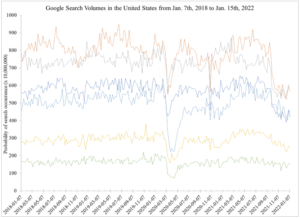

Figure 1: Google search frequencies from January 2018 through January 2022, divided in weekly intervals. Search frequencies for exploratory terms decreased comparatively less and recovered to pre-pandemic volumes faster than searches for interventional terms initially, but this relationship reversed as the pandemic went into the year 2022.
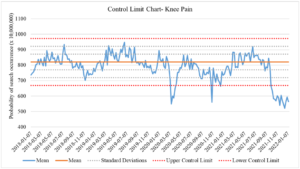
Figure 2: Control limit analysis for “knee pain” demonstrating the first significant decrease in search volumes in March 2020 and subsequent out of control events. Pre-pandemic mean is defined as the mean search frequency from January 7th, 2018, to March 1st, 2019. UCL (upper control limit) and LCL (lower control limit) represent three standard deviations from the pre-pandemic mean search frequency.

Figure 3: Control limit analysis for “knee interventions” demonstrating the first significant decrease in search volumes in March 2020 and subsequent out of control events. Pre-pandemic mean is defined as the mean search frequency from January 7th, 2018, to March 1st, 2019. UCL (upper control limit) and LCL (lower control limit) represent three standard deviations from the pre-pandemic mean search frequency.
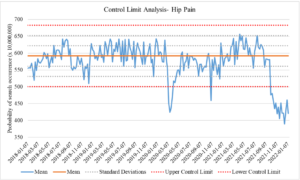
Figure 4: Control limit analysis for “hip pain” demonstrating the first significant decrease in search volumes in March 2020 and subsequent out of control events. Pre-pandemic mean is defined as the mean search frequency from January 7th, 2018, to March 1st, 2019. UCL (upper control limit) and LCL (lower control limit) represent three standard deviations from the pre-pandemic mean search frequency.
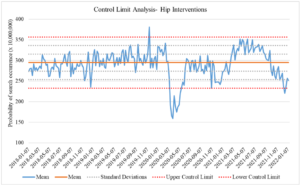
Figure 5: Control limit analysis for “hip interventions” demonstrating the first significant decrease in search volumes in March 2020 and subsequent out of control events. Pre-pandemic mean is defined as the mean search frequency from January 7th, 2018, to March 1st, 2019. UCL (upper control limit) and LCL (lower control limit) represent three standard deviations from the pre-pandemic mean search frequency.
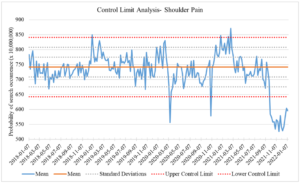
Figure 6: Control limit analysis for “shoulder pain” demonstrating the first significant decrease in search volumes in March 2020 and subsequent out of control events. Pre-pandemic mean is defined as the mean search frequency from January 7th, 2018, to March 1st, 2019. UCL (upper control limit) and LCL (lower control limit) represent three standard deviations from the pre-pandemic mean search frequency.
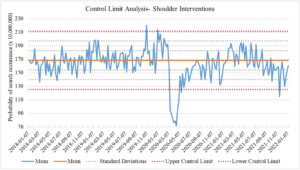
Figure 7: Control limit analysis for “shoulder interventions” demonstrating the first significant decrease in search volumes in March 2020 and subsequent out of control events. Pre-pandemic mean is defined as the mean search frequency from January 7th, 2018, to March 1st, 2019. UCL (upper control limit) and LCL (lower control limit) represent three standard deviations from the pre-pandemic mean search frequency. ✝Percentage change between pre-pandemic mean and lowest search frequency during initial drop in March 2020. 0.013
Query Term
Pre-Pandemic Mean*
Pandemic Mean*
Pandemic Search Drop✝
Exploratory Terms
Hip Pain
592 +/- 30
556 +/- 67
28%
Knee Pain
821 +/- 50
750 +/- 100
33%
Shoulder Pain
745 +/ 35
708 +/- 79
25%
Interventional Terms
Hip Interventions
297 +/- 21
282 +/- 44
46%
Knee Interventions
523 +/- 32
473 +/ 83
57%
Shoulder Interventions
171 +/ 16
155 +/- 26
58%
*Search probability is reported as number of Google searches per 107 searches
Time to Recovery Average Recovery (Weeks) (Weeks)
P-value*
Exploratory Terms
Hip Pain
4
3.0
Knee Pain
4
Shoulder Pain
1
Interventional Terms
Hip Interventions
9
9.7
Knee Interventions
12
Shoulder Interventions
8
*Student’s t-test
There were subsequent out of control events for both exploratory and interventional search terms during the 2020 holiday season before a period of increased interest and special cause variations in April, May, and June 2021for all search terms except knee exploratory and shoulder interventional terms. After July 2021, search frequencies for exploratory terms trended down to an all-time low, while search frequencies for interventional terms did not show such a dramatic drop. Interventional terms did still demonstrate special cause variations and search frequencies below the LCL until the end of the search window.
Discussion
This study aimed to gain insight into public interest for common orthopaedic symptoms and their respective elective orthopaedic procedures as the COVID-19 pandemic has progressed. Our results showed that public interest declined sharply in 2020, once in March and again during the winter holiday season. Public interest in orthopaedics seemed to be recovering in the spring and summer of 2021 but was then found to fall again after the introduction of new variants of COVID-19. As of January 2022, the public interest in many orthopaedic conditions remains significantly depressed compared to before the pandemic. The search frequencies of exploratory terms were less influenced by the COVID-19 pandemic initially and recovered faster than those of interventional terms. As the pandemic progressed, search frequencies for interventional terms showed comparative resilience to resurgent caseloads in the final months of 2021 and beginning of 2022. Most significantly, search frequencies for all terms demonstrated volatility until the end of study period.
These findings and the method in which they were reached are both important additions to the literature as exploring the recovery of interest in orthopaedic procedures allows physicians, healthcare systems, and policymakers to better understand and anticipate the needs of their patient populations. By analyzing the public’s response to real-world events, stakeholders can interpret their real-time reactions and respond to them. Using the COVID-19 pandemic as an example of a disturbance to the supply and demand of orthopaedic procedures allows researchers to see both the effect of this disturbance and the timeline until which equilibrium is restored. This study showed that the public initially did lose interest in elective orthopaedic procedures during the same week as the surgeon general announced a halt to these operations [1, 25]. The public interest in interventional terms dropped more significantly than the exploratory terms prior to June 2020. However, as the COVID-19 pandemic progressed, the data no longer demonstrated this relationship between interest in orthopaedic symptomology and procedures. In fact, the opposite was found. Even with the January 2022 COVID-19 caseload nearly four times higher than previously seen, elective surgeries canceled once again, and hospitals lacking adequate staffing, the public interest in elective orthopaedic procedures is higher than it was during the 2020 holidays [8]. This disassociation may reflect the public fatigue regarding COVID-19 or the quality-of-life challenges faced by patients during this time, leading them to grow restless to receive their procedures. Studies have shown that patients during the pandemic have suffered from increased rates of weight gain, drug abuse, and psychological disease, and these factors may be compounded in patients dealing with chronic pain, an area of further research [6, 16, 17].
Compared to similar studies, this study expanded on the symptoms, procedures, and window of time evaluated, as well as utilized a more accurate and reliable data extraction tool [15]. Combining these GETH data findings with the known surgical case backlog suggests a potential application of Google Trends for identifying bottlenecks in the healthcare process from symptom onset to treatment to recovery. Hospital systems and policymakers could leverage the methodology used in this study to identify bottlenecks in other aspects of patient care, such as examining interest in rehabilitation centers for chronic pain or postoperative care. They could then tailor patient outreach and distribute healthcare resources proportionally based on a timely assessment of community interest. The Google Trends Extraction tool also allows for the collection of data by state. This increased granularity could be used to analyze how individual states have been affected by COVID-19. Additionally, the recovery of interest in elective orthopaedic procedures could drive policy changes or scheduling flexibility in the clinic or operating room, tailored to the needs of their patient population. Studies have demonstrated the seasonality of interest and concurrent increase in surgical demand during those times, and further studies should explore the efficacy of applying this seasonality to staffing or supply chains [3].
This study should be viewed within the scope of its limitations. The monthly unemployment rate rose from 4% in March 2020 to 15% in April 2020 [11]. Patients’ loss of health insurance through their employer may have contributed to decreased search frequency but not decreased interest in elective procedures. Additionally, there is also no way to discern the demographics of who is searching on Google, and this is a limitation in all Google Trends/ GETH studies. Some subgroups who do not search online or in English are likely left out from this data collection, however the majority of the United States is both digitally and English literate, so these limitations do not invalidate these results [12, 19]. The exact search terms used in this study only capture one specific symptom, pain, thus underestimating the true interest for orthopaedic complaints. Finally, the COVID-19 pandemic is actively evolving, so this study is limited by the most current data available. Despite these limitations, this study can be used to better understand, quantify, and potentially anticipate the interests of the national patient population and tailor care, public outreach programs, or policy based on timely search trends.
Conclusion
Our study has demonstrated a novel use of GETH data to measure public interest in orthopaedics since the beginning of the COVID-19 pandemic by applying the Google Trends Extraction Tool and utilizing control limit analysis. Analyzing special cause variations within those search windows, a marked decrease in public interest for orthopaedics occurred in March 2020, followed by an initial recovery but then subsequent volatility until the end of the study period. By the end of the study period, full recovery of public interest in elective orthopaedic procedures to baseline pre-pandemic levels had not yet been reached. With the application of the Google Trends Extraction Tool, our study is the first to record any resurgence in public interest in elective orthopaedics as the COVID-19 pandemic has progressed and provides a timely update to the literature as new variants continue develop. With GETH and the Google Trends Extraction tool, orthopaedic surgeons, hospital systems, and other stakeholders can easily and accurately gauge public interest in several common orthopaedic symptoms and procedures and utilize those data to make better-informed decisions about patient care, preventative action, or policy changes.
References
- WHO Director-General’s opening remarks at the media briefing on COVID-19 - 11 March 2020. WHO Dir-Gen Open Remarks Media Brief COVID-19 - 11 March 2020.
- Arora VS, McKee M, Stuckler D. Google Trends: Opportunities and limitations in health and health policy research. Health Policy. 2019; 123:338-341.
- Cohen SA, Cohen LE, Tijerina JD, Bouz G, Lefebvre R, Stevanovic M, Heckmann ND. Google trends as a tool for evaluating public interest in total knee arthroplasty and total hip arthroplasty. J Clin Transl Res. 2021 Jul 16; 7:456-466.
- Benneyan JC. Statistical process control as a tool for research and healthcare improvement. Qual Saf Health Care. 2003; 12:458-464.
- . Bhambhvani HP, Tijerina JD, Parham MJ, Greenberg DR, Eisenberg ML. Public Interest in Elective Urological Procedures in the COVID-19 Pandemic: A Google Trends Analysis. Urol Pract. 2020; 7:496-501.
- Bhutani S, vanDellen MR, Cooper JA. Longitudinal Weight Gain and Related Risk Behaviors during the COVID-19 Pandemic in Adults in the US. Nutrients. 2021; 13:671.
- Brown TS, Bedard NA, Rojas EO, Anthony CA, Schwarzkopf R, Barnes CL, Stambough JB, Mears SC, Edwards PK, Nandi S, Prieto HA, Parvizi J. The Effect of the COVID-19 Pandemic on Electively Scheduled Hip and Knee Arthroplasty Patients in the United States. J Arthroplasty. 2020; 35:S49-S55.
- Center for Disease Control. Trends in Number of COVID-19 Cases and Deaths in the US Reported to CDC, by State/Territory. COVID Data Tracker. 2021.
- Cohen SA, Zhuang T, Xiao M, Michaud JB, Shapiro L, Kamal RN. Using Google Trends Data to Track Healthcare Use for Hand Osteoarthritis. Cureus. 2021.
- Czeisler MÉ, Marynak K, Clarke KEN, Salah Z, Shakya I, Thierry JM, Ali N, McMillan H, Wiley JF, Weaver MD, Czeisler CA, Rajaratnam SMW, Howard ME. Delay or Avoidance of Medical Care Because of COVID-19–Related Concerns -United States, June 2020. 2020;69:8.
- Department of Labor US. The Employment Situation - October 2021. Bur Labor Stat.:41.
- Eibner W. International Economic Integration: Selected International Organizations and the European Union. München: Oldenbourg Verlag; 2007.
- Jain A, Jain P, Aggarwal S. SARS-CoV-2 Impact on Elective Orthopaedic Surgery: Implications for Post-Pandemic Recovery. J Bone Jt Surg. 2020; 102:e68.
- Jella TK, Samuel LT, Acuña AJ, Emara AK, Kamath AF. Rapid Decline in Online Search Queries for Hip and Knee Arthroplasties Concurrent With the COVID-19 Pandemic. J Arthroplasty. 2020; 35:2813-2819.
- Landy DC, Chalmers BP, Utset-Ward TJ, Ast MP. Public Interest in Knee Replacement Fell During the Onset of the COVID-19 Pandemic: A Google Trends Analysis. HSS J ®. 2020; 16:24-28.
- Mazza C, Ricci E, Biondi S, Colasanti M, Ferracuti S, Napoli C, Roma P. A Nationwide Survey of Psychological Distress among Italian People during the COVID-19 Pandemic: Immediate Psychological Responses and Associated Factors. Int J Environ Res Public Health. 2020; 17:3165.
- Niles JK, Gudin J, Radcliff J, Kaufman HW. The Opioid Epidemic Within the COVID-19 Pandemic: Drug Testing in 2020. Popul Health Manag. 2021; 24:S-43-S-51.
- Nuti SV, Wayda B, Ranasinghe I, Wang S, Dreyer RP, Chen SI, Murugiah K. The Use of Google Trends in Health Care Research: A Systematic Review Voracek M, ed. PLoS ONE. 2014; 9:e109583.
- OECD Skills Outlook 2013: First Results from the Survey of Adult Skills. OECD; 2013.
- Poirier C, Lavenu A, Bertaud V, Campillo-Gimenez B, Chazard E, Cuggia M, Bouzillé G Real Time Influenza Monitoring Using Hospital Big Data in Combination with Machine Learning Methods: Comparison Study JMIR Public Health Surveill 2018;4(4):e11361.
- Raubenheimer JE. Google Trends Extraction Tool for Google Trends Extended for Health data. Softw Impacts. 2021; 8:100060.
- Raubenheimer JE, Riordan BC, Merrill JE, Winter T, Ward RM, Scarf D, Buckley NA. Hey Google! will New Zealand vote to legalise cannabis? Using Google Trends data to predict the outcome of the 2020 New Zealand cannabis referendum. Int J Drug Policy. 2021; 90:103083.
- Scott CEH, MacDonald DJ, Howie CR. ‘Worse than death’ and waiting for a joint arthroplasty. Bone Jt J. 2019;101-B:941-950.
- Subhash AK, Maldonado DR, Kajikawa TM, Chen SL, Stavrakis A, Photopoulos C. Public Interest in Sports Medicine and Surgery (Anterior Cruciate Ligament, Meniscus, Rotator Cuff) Topics Declined Following the COVID-19 Outbreak. Arthrosc Sports Med Rehabil. 2021; 3:e149-e154.
- Sussanah L. Surgeon General advises hospitals to cancel elective surgeries. Surg Gen Advis Hosp Cancel Elect Surgeries.
- Tijerina JD, Cohen SA, Parham MJ, Debbaut C, Cohen L, Stevanovic M, Lefebvre R. Public Interest in Elective Orthopedic Surgery Following Recommendations During COVID-19: A Google Trends Analysis. Cureus. 2020.
- Tijerina JD, Morrison SD, Nolan IT, Vail DG, Lee GK, Nazerali R. Analysis and Interpretation of Google Trends Data on Public Interest in Cosmetic Body Procedures. Aesthet Surg J. 2020;40:NP34-NP43.